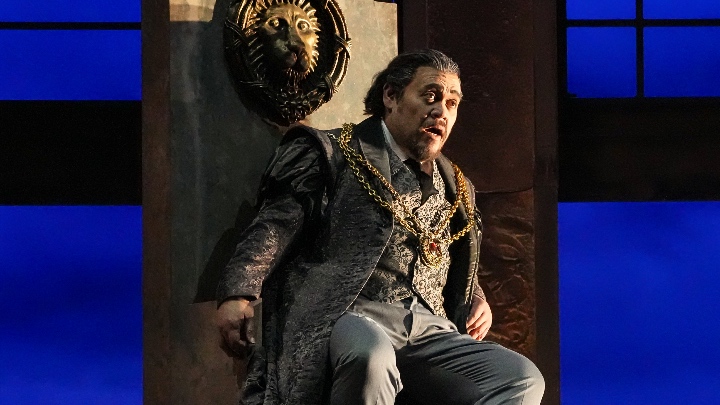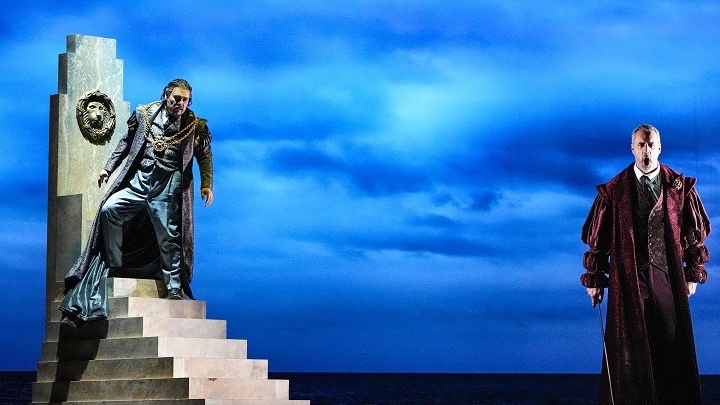
Verdi’s Simon Boccanegra had its premiere in 1857 at La Fenice in Venice, and was revised and “re-premiered” at La Scala in 1881. In the intervening 24 years came Un Ballo in Maschera, La Forza del Destino, Don Carlos and Don Carlo, and Aida, as well as some additional tweaking to Macbeth. Simon Boccanegra is not a forgotten opera; then and now, it holds a place in the repertory. Still, seeing it on the continuum, it’s clearly in the shadow of those others, whose name recognition and status place them centrally in the public imagination as masterpieces.
Hearing the opera last evening in Philadelphia as a pillar of Festival O23—in a very distinguished and sometime revelatory evening—I wondered why.
Yes, it has a plot that confuses me more every time I return to it. (Some key ingredients: 14th Century Genoa politics over many years, aristocrats vs. plebeians, and hidden identities. I can’t really help beyond that. Google it yourselves, if you dare.) But it’s more coherent than Il Trovatore, to name another Verdi favorite… and similar themes haven’t tarnished the reputation of Rigoletto.
Yes, there’s no opera jukebox hit tune to rival “La donna e mobile,” or the Marcia Trionfale; though I’d say the lilting, gently rocking opening theme—which frequently repeats during the work—is a memorably haunting evocation of a calm but somehow not wholly comforting oceanic panorama. (The sea is recurring motif here in several ways.)
More to the point, the entire score is under-appreciated: much of it is Verdi in absolutely peak form. The Prologue, with its concentration of lower-voiced male characters, instills a quality of dark seriousness that keeps the audience in its grasp from the beginning. The segue from that into “Come in quest’ora bruna,”Amelia’s entrance, where shimmering moonlight breaks through the gloom—is sheer magic. Those are a couple of my favorite moments; you’ll have your own, I’m sure.
But Simon Boccanegra is not an easy piece to get right. The vocal challenges are considerable; the dramatic ones equally so. As a middle-period Verdi work, we’re in a world where recognizably separate musical numbers are less distinct. The focus more often is woven into an on-going tapestry of sound.
At the same time, while Verdi has largely abandoned ornamental writing by this point, the sense of bel canto line remains a goal.
It was that quality that for me was especially welcome last night. The title part of Simon was a role debut for baritone Quinn Kelsey, who scored a triumph. Every word made its point, and every honeyed tone was placed perfectly in a long line, with what seemed like infinite dynamic gradations. (Now that is bel canto!) A single word—“Figlia!”—held for what seemed like minutes—brought a collective gasp from the audience. Kelsey is also a riveting, focused actor who knows how to use stillness on a stage.
If the others weren’t quite as special as that, the standard was very high. Christian Van Horn (Fiesco) also brings a sense of dignified presence to role that too often turns into roaring, stock villainy. As with Kelsey, he emphasized the sense of line—some of the role lies low for him, but he made it work within his means, and was especially fine in the more lyrical sections. Benjamin Taylor was excellent vocally and dramatically in the prominent secondary role (also a baritone) of Paolo.
Two other performers proved more mixed. Richard Trey Smagur played Gabriele Adorno. The raw material is certainly noteworthy—it’s an ample, lustrous lyric tenor capable of ringing volume, but also notable piano singing. But his performance was maddeningly uneven, with lovely phrases alternating with clumsy ones, and ultimately little sense of either musical or dramatic shape.
That was most emphatically not the case with the Amelia of Ana Maria Martínez. She is in every sense a sovereign artist. Details are thoroughly worked out, and she has a focused, elegant stage presence. Her soprano—a highly individual, resinous timbre with a burnt umber vocal coloration—is fascinating. But it’s a rather odd fit for Amelia, a role we associate with a sunnier, more open vocal coloration and a sense of soaring openness. (The pianissimo moments sometimes worked for Martínez; at other times not.)
The aforementioned “Come in quest’ora bruna” for me served as a lesson in artistry. Traditionally, it’s all about freedom and float, with a climactic B-flat launched over the orchestra that opera lovers wait for. Here it was… fine: well-enough done, solidly placed, but neither soft nor effortless.
But here’s where it gets interesting. I have the sense that both Martínez and conductor Corrado Rovaris knew it going in. Together, they found a different way to make the aria weave its spell. Rather than a gauzily beautiful paean to the evening light, here it was sharper, tauter, faster. An undercurrent of anxiety permeated the moment in a way that absolutely reinvented it.
It was indeed a sensational moment for Rovaris. I would say one of many, but that minimizes his achievement—this was more than a collection of beautifully done sections, though there were plenty of them. This was Verdian line delivered by a conductor who has mastered the idiom completely. It follows that orchestral playing and choral singing (under the direction of company Chorus Master Elizabeth Braden) were of a similarly high standard.
I realize I’ve said little about the production (by director Laurence Dale, with scenery by Gary McCann, lighting by John Bishop, and costumes by Fernand Ruiz). It’s an elegant affair that cannily mixes periods to simultaneously suggest the Renaissance setting and its sinister later resonances (Mussolini’s regime is legible in the visual world.) For all the bustle (this work is full of crowd scenes) there is a welcome sparseness and austerity, that makes particular effect in the poignant final scene.
In sum: not a perfect Simon Boccanegra—is there such a thing?—but a grand and often great one. Bravi tutti!
Photos: Steven Pisano



























Comments